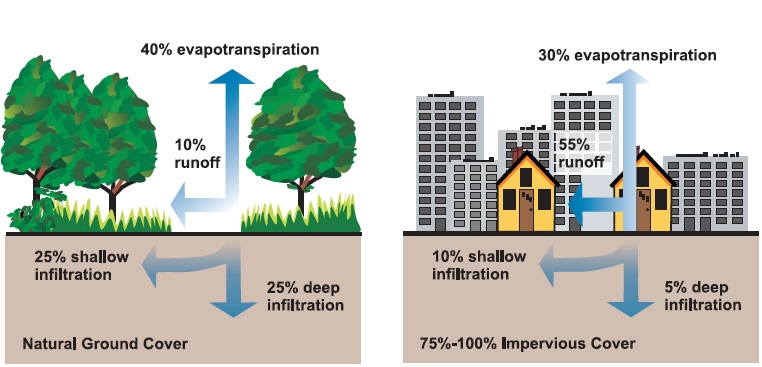By Rachael Meyer
Treated stormwater runs in Rachael Meyer’s blood. Leading Weber Thompson’s Landscape Architecture and Sustainability Design teams, she harnesses the passion of others to better our environment.
The content for this article was originally featured in the NAIOP WA Blog on March 17, 2022.
Stormwater Goals: Slow, Clean, and Cold
Development projects in the Puget Sound region are generating more conversations about stormwater management than ever before. In many ways the Pacific Northwest is on the leading edge in terms of both regulatory updates and elective sustainable design measures implemented by local developers. Every year projects look more progressive than the prior year, and stormwater has become a much more integral part of site design for urban infill projects.
Recognizing why thoughtful design is required and ensuring community understanding is a critical to ongoing acceptance and education. To distill the goals of stormwater management in a sentence, codified by several thousand pages of Stormwater Management Manuals: development projects strive to match the site hydrology of a native pre-developed condition. In other words, water should enter and leave the site at the same rates that it did before humans began changing the landscape. The goal is for the downstream inhabitants of any project (people, wildlife, and plant communities) to be blissfully unaware that redevelopment has occurred and that the ecology surrounding the project can continue to thrive. Controlling nutrient and pollutant loads, run-off rates and volumes, and groundwater re-charge are all key elements to reducing environmental impact.

When Redevelopment Occurs Stormwater Wins
Stormwater mitigation hasn’t always been what it is today, and it wasn’t all that long ago that next to nothing was done to protect surface waters and surrounding habitat as the region developed. Prior to the 1972 Clean Water Act, there was little to no formal regulation regarding stormwater management. Developments commonly increased the amount of run-off and pollutants that flowed into surrounding waters. Many are surprised to learn that as much as 90% of Puget Sound roadways and urban areas are directly discharged to local streams and rivers with little to no mitigation.
Today with few exceptions, stormwater treatment measures are installed when re-development occurs. This means most of the new green infrastructure in Seattle and other major cities are built as part of any new development on private or public property. Stormwater improvements come in the form of covered parking, green roofs, bio-retention planters and swales, rainwater harvesting cisterns, and stormwater detention facilities along with street trees and vegetation. The goal is to both filter run-off and reduce the volume and rate of flow to prevent overwhelming infrastructure (such as our combined storm/sewer systems).
Site Specific Design: Getting Credit for the Investment
The ever-increasing complexity of stormwater regulation comes with the potential for added costs. It is important to look at the ecological benefits provided and select strategies that will support overall project goals. Property owners and developers make huge financial contributions to stormwater management – and there are many ways to go about meeting these requirements. It is important to make sure those dollars are going to the most impactful places. Many times, those are in public or shared open spaces that enhance a project.
Local Updates for 2021
The City of Seattle Stormwater Codes were updated in 2016 and again in 2021. The recent revisions have adjusted the amount of Green Stormwater Infrastructure that is required, with both increases and reductions to different aspects of the code. Most stormwater mitigation strategies are going to be best integrated into developments during the early phases of a project. Ask your landscape and civil teams to explain how much site area will be needed for both stormwater quality and quantity mitigation as well as stormwater detention. Some projects may need to address a few aspects of management; others may be required to address all of them.
Most projects can expect an increase in stormwater detention vault sizes from approximately 3,000 cubic feet of storage to 7,000 cubic feet per acre of development. Green Roof sizing for On-site Stormwater Management remains the same: mitigating at a 1:1 ratio (mitigates the surface it’s covering). Bio-Retention Planters on the other hand have seen a drastic decrease in sizing requirements from a previous ratio of approximately 17:1 to nearly 80:1, or one square foot of bio-retention per 80 square feet of impervious area.
This blog was written by Aaron Fjelstad (Coughlin Porter Lundeen) and Rachael Meyer (Weber Thompson) as part of their ongoing Sustainability Mindset series.
